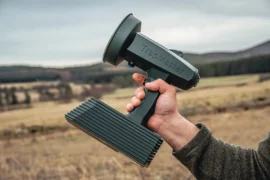From our September/October 2025 Issue
I hadn’t been looking for the gun. It found me. I was browsing an online gun-auction site, and there it was. Though the photographs were sketchy, the unmistakable lines of a British best game gun caught my eye: a William Powell & Son 16-bore boxlock ejector with double triggers, probably made near the end of the 19th Century. The description said only that it had “trigger and forend” issues but was otherwise in “very good” condition. I couldn’t resist. I rolled the dice and placed a ridiculously low bid. I turned in that night confident there was no way I would win the dubious double and be forced into another costly gun project I didn’t need.
I was surprised—and somewhat dismayed—the next morning when I checked my email and saw that I had won the auction. I reread the terms of sale. “As is, no returns, no refunds and no whining” was written in bold print at the bottom of the description. Buyer’s remorse was rearing its ugly head. Had I just bought the proverbial pig in a poke? Would I be forced to turn a battered sow’s ear back into the Birmingham silk purse it once had been?
When the side-by-side arrived a week or so later, I removed it from the carton, disassembled it and did a quick triage of its injuries. Somewhere during its apocryphal past someone had lost the splinter-forend finial and screw and removed the Deeley-patented ejector mechanism. There was also a small, jagged hole in the bottom rear of the forend wood where the ejector box had once been housed. Of course, none of this had been mentioned in the cryptic item description or could be seen clearly in the out-of-focus auction photographs. But the barrels—the very heart of every good game gun—looked great . . . until I examined the breech end and saw the word “sleeved” glaring on the left and right barrel flats. The top rib was also missing its bead at the muzzles. The gold number “1” on the rib was gone as well.
My spirits sank in tandem with the sinking feeling in my stomach. “Caveat emptor” echoed in my head. However, I did discover a few redeeming qualities about the neglected old 16. The sleeving job had been seamlessly done; the bores were free of pits; and the barrels rang true, were snug against the standing breech and retained 99 percent of their rust bluing. Like most English game guns of its era, the Powell was chambered for 2 1⁄2" shells. Overall, despite its many maladies, the old Powell exuded a subtle, refined elegance that still stirred my sporting heart.
Next I inspected the receiver. Like the colorless frame, the forend iron, toplever, bottom plate of the action and trigger guard all had a hand-worn, silver luster. The full-cover-age engraving, though beautifully executed, had softened with age. Apparently one of a set of guns, the gold “1” inlaid on the toplever, like the barrels, had been mined at some point along with the gold “SAFE” in front of the safety catch. I reassembled the gun and pushed forward on the safety. It didn’t budge. Would the gun even shoot? I applied a liberal dose of gun oil around the catch and let it work overnight, hoping it would release whatever gremlin had a grip on the mechanism.
The next morning the safety catch begrudgingly moved forward and back. I assembled the gun, broke it open and loaded a pair of 16-gauge snap caps. When I brought the barrels up to the receiver, the doll’s-head third grip engaged with solid authority. I held my breath and tripped the triggers. A tribute to the talented craftsmen of England’s gunmaking golden age, both triggers released crisp and clean: 4 pounds front, 4 1⁄2 pounds rear. It was easy to see why William Powell & Son has been called the “Purdey of Birmingham.” I thumbed over the toplever and dropped down the barrels. The automatic safety reset, and the locks cocked smoothly. Adorned with a rock-hard Silvers recoil pad and pockmarked silver oval name plate, the scourged buttstock was too short and cast in the wrong direction for my dominant left eye. I was still holding out hope, but the challenges of this English sub-gauge gun were becoming more daunting the more I looked.
Before I caved in to the temptation to do a bank-breaking restoration and have the gun restocked to my dimensions, I called J.J. Perodeau, a talented gunmaker in Sand Springs, Oklahoma. I explained the litany of issues affecting the Popwell and awaited his wise advice and counsel. He recommended that, because the barrels were sleeved and the ejector mechanism was missing, I not throw good money after bad. and just keep the gun as a wall-hanger. Considering the paltry sum I had paid for the gun, it was certainly worth that. J.J. went on to say that the cost of replacing the ejector box alone—if one could even be found—would make the project prohibitive. Of course, he was right. But I wasn’t ready to admit defeat just yet.
Though I may have been taken by the auction seller, I was still taken in by the graceful lines of the Powell’s straight-grip stock, captivated by the delicate rose & scroll engraving, enamored with the gracefully beaded fences and won over by how effortlessly the 28-inch barrels pointed and swung. Though a tad barrel heavy because of the sleeving, the extra weight out front would aid with the follow-through so essential to consistent wingshooting. In spite of it all, the old game gun was still a delightful wand, weighing a shade more than six pounds and balancing just forward of the hinge pin. Bored .004" in the right choke and .009" in the left, the open-choked gun would be perfect for the light, one-ounce “square” loads I used for ruffed grouse and woodcock.
Seduced by the Powell’s elegant symmetry, I was powerless to prevent the sweet little 16-bore from working its magic on me. Somehow I had to return it to the game fields. A hopeless perfectionist with all my game guns, I also had to find a way to get past its numerous imperfections and add it to the gun cabinet. How could I rationalize restoring and shooting this beleaguered boxlock? Then it hit me: rain gun! For years I had wanted a vintage double gun I could use when the woodcock thickets and grouse woods are rain-soaked. When brushing against a balsam or bumping a tag alder drenches everything. I needed a gun I didn’t have to worry about getting wet. The old Powell would be my rainy-day gun. No more sulking in my motel room during a northwoods grouse and woodcock hunt when the fall rain gods appeared.
My next call was to gunsmith and friend Pete Forthofer, in Polson, Montana. I explained my predicament and lamented the Powell’s lack of ejetors among other things. He listened patiently, then told me to drop off the gun after elk season. Before hanging up, he also suggested that I adjust my purist attitude, swallow my pride and hunt with it as an extractor gun. Sensing my concern about the Powell’s mechanical condiotion, he further consoled me by saying that its simple and robust Anson & Deeley boxlock action was virtually bulletproof and easier to repair than its sidelock brethen.
A few weeks later I delivered the double to Pete’s shop. During the ensuing month, he stripped, cleaned and lubricated the action and adjusted the safety catch to slide smoothly forward and back. After cleaning up and indexing all of the screw heads, he canted the triggers for my left hand. He finished off the barrels with a silver bead at the muzzle. When I picked up the Powell, Pete said it had good bones and, with proper care and light loads, the gun still had many bird seasons left in it. I returned home, patched the hole in the forend wood and used a heat gun to coax a hair of cast-on into the straight-grained stock. Then I put a slip-on pad over the rigid Silvers, to give me another inch of length of pull. When I test-fired the Powell, both barrels patterned beautifully at 30 yards. It now fit and shot where I looked. Hopefully, it would do so with rain-filled eyes and fogged-up shooting glasses.
Curious about the gun’s pedigree, I contacted William Powell in the UK for any information the company might have. The venerable Birmingham gunmaker had been crafting fine game guns continuosly sine 1802, and the records indicated that my gun had been one of a matched trio of 16-bore ejector guns built at 35 Carrs Lane, Birmingham, for a high-born English Earl in September 1889—nearly 15 years after the 1875 Anson & Deeley boxlock patent and just five years after John Deeley recived patent No. 14526 for his ejector-box mechanism. The Powell was made around the time nitro powders and fluid-steel barrels began nudging out black powder and Damascus barrels. It also was the era when these revolutionary boxlocks were competing with evolutionary sidelocks for bragging rights on the grouse moors.
Along with its royal lineage, the fact that the Powell was a high-grade 16-bore ejector made when ejector guns were just beginning their reign and 12-bores dominated England’s game fields underscored its rarity. Most sub-gauge guns in the UK were built for lads and ladies—relatively few of them at that, and they usually had shorter lengths of pull, requiring stock extensions or restocking for gentlemen shooters. Given its 14-inch length of pull, the Powell was probably made for an adult, perhaps the Earl himself. The trio of 16s was sold three more times by Powell until 1929, when world stock markets crashed and the maker lost track of the guns. How No. 1 of the set arrived on this side of the pond is a mystery. After more than 136 years, one could only imagine the fate of its two case mates and the interesting stories they could tell.
My “royal” rain gun now resides proudly in my gun cabinet and gets the same care and attention given to all my game guns. It serves me well in the fall when the heavens open up to wash down the hunting grounds. Second string though it may be, the little Powell is always carefully dried, thoroughly cleaned and properly lubricated after every slosh through the water-soaked uplands. Am I still tempted to have the gold “1” inlaid back into the toplever and barrel rib; to have the gold “SAFE” bar returned to its dove-tailed slot in front of the safety catch; to replace the missing forend finial and screw; to have the engraving touched-up on the doll’s-head barrel extension and around the breech ends of the barrels; and to have the maker’s faded name and address re-engraved on the top rib? Will I still keep my eyes open for a Deeley-patent ejector box to make the gun whole again? Absolutely. Do I fantasize about restocking the antique Powell with the aged and streaky English walnut blank I have been saving for a rainy day? You bet I do. But for now I am content to just hunt and enjoy my English best “extractor” gun come rain or shine.
Read our Newsletter
Stay connected to the best of wingshooting & fine guns with additional free content, special offers and promotions.




